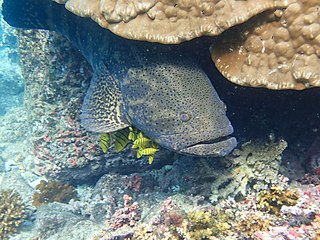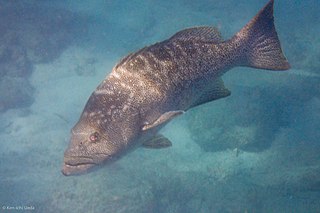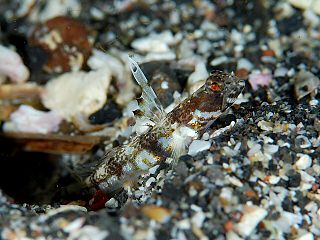Collared wrigglers are perciform fishes in the family Xenisthmidae. They are native to the Indian and Pacific Oceans, where they are mostly reef-dwelling.

The smooth grouper is a species of marine ray-finned fish, a grouper from the subfamily Epinephelinae which is part of the family Serranidae, which also includes the anthias and sea basses. It is associated with reefs and is found in the western Indian Ocean.
The Venezuelan grouper is a species of marine ray-finned fish, a grouper from the subfamily Epinephelinae which is part of the family Serranidae, which also includes the anthias and sea basses. It is found in northern South America and the Greater Antilles.

The Pacific goliath grouper, also known as the Pacific itajara grouper, is a species of marine ray-finned fish, a grouper from the subfamily Epinephelinae which is part of the family Serranidae, which also includes the anthias and sea basses. It is found in the eastern Pacific Ocean where it is associated with reefs. It is related to the Atlantic goliath grouper.

Cephalopholis fulva, the coney or the butterfish, is a species of marine ray-finned fish, a grouper from the subfamily Epinephelinae which is in the family Serranidae which also includes the anthias and sea basses. It is found in the western Atlantic. It is associated with reefs and is a quarry species for commercial and recreational fisheries. It can be found in the aquarium trade.

Mycteroperca rosacea, the leopard grouper or golden grouper, is a species of marine ray-finned fish, a grouper from the subfamily Epinephelinae which is part of the family Serranidae, which also includes the anthias and sea basses. It is found in the Eastern Central Pacific that occasionally makes its way into the aquarium trade.

The longfin grouper, also known as the longfin rockcod, bar-breasted rock-cod, Gilbert's rock-cod, honeycomb rockcod, spotted groper or wirenet cod, is a species of marine ray-finned fish, a grouper from the subfamily Epinephelinae which is part of the family Serranidae, which also includes the anthias and sea basses. It is found in the Western Pacific Ocean.

Xenisthmus is the most well-known genus in the family Xenisthmidae, which is regarded as a synonymous with the Eleotridae, a part of Gobiiformes. These small to very small fish are known as wrigglers, and live in reefs and among rubble in the Indo-Pacific.
Xenisthmus balius is a species of fish in the Xenisthmidae (wriggler) family, which is regarded as a synonymous with the Eleotridae,. It is found in the Persian Gulf.

Xenisthmus clarus, better known as the clear wriggler, is a species of fish in the Xenisthmidae (wriggler) family, which is regarded as a synonymous with the Eleotridae.

The slender grouper is a species of marine ray-finned fish, a grouper from the subfamily Epinephelinae which is part of the family Serranidae, which also includes the anthias and sea basses. It is the only species in the genus Anyperodon. It is found in the Indo-Pacific region.
Xenisthmus eirospilus, the spotted wriggler, is a species of fish in the wriggler family, Xenisthmidae, which is regarded as a synonymous with the Eleotridae,. It is distributed in the western Pacific from Middleton Reef and Ashmore Reef off Australia, West Papua, Indonesia, to Rotuma and Tonga. Its habitat is sand patches among reefs and rubble, as well as in shallow surge areas.
Xenisthmus semicinctus, the halfbelt wriggler, is a species of fish in the wriggler family, Xenisthmidae, which is regarded as a synonymous with the Eleotridae,.

The largetooth goby, also known as Wilbur's goby, is a species of ray-finned fish from the family Gobiidae which is native to the Indo-Pacific from the Seychelles to Micronesia. Its known range has been extended to the Red Sea as specimens were photographed at one site and collected at another site off Egypt. This species lives in sheltered marine waters at depths of from 0 to 20 metres preferring areas with sandy substrates. This species grows to a length of 6.5 centimetres (2.6 in) SL. This species is the only known member of its genus. This species is not obviously sexually dimorphic and it has a background colour of pale brown to greenish-brown and a pale ventral side. The body is marked with brown and white spots, pairs of larger brown spots create a mid-lateral row along its flanks and there is a dark spot on the caudal fin peduncle. It has a brown blotch on the cheek and a series of short brown bars along its back. The largetooth goby is a solitary fish which is found in coastal bays, lagoons and estuaries over fine sandy substrates close to the margins of reefs or silt beds in the vicinity of sheltered and often turbid coastal reefs. It is most frequently collected from shallow waters to 7 metres (23 ft), around coral reefs but off southern Japan, the largetooth goby occurs at the bottom of sandy bays. The specific name honours the American physician, Ray Lyman Wilbur (1875–1949) who was president of Stanford University from 1916–1943, as well as being the United States Secretary of the Interior from 1929–1933. Wilbur helped the author, Herre, get to Palau, the type locality of this species.

Epinephelus bruneus, the longtooth grouper, is a species of marine ray-finned fish, a grouper from the subfamily Epinephelinae which is part of the family Serranidae, which also includes the anthias and sea basses. It is found in northwest Pacific in eastern Asia.
The ladder pipefish is a species of marine fish of the family Syngnathidae. It is endemic to Western Australia, occurring from Shark Bay to the Monte Bello Islands. It is a habitat generalist, with species samples being taken from trawls, from among weeds and algae and one sample from a pond. It is reported to occur on rocky-reefs in inlets, bays and lagoons, as well as shallow seagrass beds. It is expected to feed on small crustaceans, and can grow to lengths of 18 centimetres (7.1 in). This species is ovoviviparous, with males brooding eggs and giving birth to live young.
Xenisthmus chapmani is a species of goby from the sleeper goby family Eleotridae which is known from a single specimen collected in Espiritu Santo Harbour, Vanuatu. Its specific name honours Dr. Wilbert M. Chapman the collector of the holotype.
Xenisthmus oligoporus, the few-pored wriggler, is a species of goby from the family Eleotridae. It is found in the Red Sea off Saudi Arabia.

Tomiyamichthys alleni, Allen's shrimpgoby, is a species of ray-finned fish from the family Gobiidae. It occurs in the western Pacific Ocean where it is commensal with an aplheid shrimp.

Cephalopholis sonnerati, known as the tomato hind, tomato rockcod, or tomato cod, is a species of marine ray-finned fish, a grouper from the subfamily Epinephelinae which is in the family Serranidae which also includes the anthias and sea basses. It is distributed on coral reefs in the tropical Indo-Pacific. It is also sometimes called the orange-spotted cod, red coral cod, red rockcod, tomato grouper, or tomato seabass.











